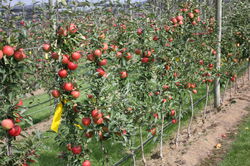 In Goethe's Faust, the character Margarete, called Gretchen, poses the main character Faust a crucial question: "Now say, where do you stand on religion? You are a dear good man, yet I believe you don’t think much of it?" According to our theme, the crucial question would be this: "Now say, where to you stand on genetic engineering? You are a dear good man, yet I believe you don’t think much of it?"
In Goethe's Faust, the character Margarete, called Gretchen, poses the main character Faust a crucial question: "Now say, where do you stand on religion? You are a dear good man, yet I believe you don’t think much of it?" According to our theme, the crucial question would be this: "Now say, where to you stand on genetic engineering? You are a dear good man, yet I believe you don’t think much of it?"
Genetic engineering as religion
At first sight, it sounds a bit strange when we replace religion with genetic engineering. In most cases, the opponents of genetic engineering have a much more missionary zeal than the breeding professors who argue in favour of genetic engineering. Nevertheless, the belief in the feasibility, mechanisation and functionalisation of plant breeding is so deeply rooted among the proponents of genetic engineering that one can rightly speak of a religion here as well: two years ago, during a conversation in the Netherlands in the greenhouse of a tomato grower, when I expressed a few doubts, the breeder that was present gazed at me with open eyes that almost pierced me – so that I very quickly felt myself to be what I was in this environment – a traitor, a heretic and a dissenter. It goes without saying, however, that the opposite side, the fundamentalist opposition to genetic engineering methods, naturally has sectarian and, above all, very religious traits, but it has the great and decisive advantage that your opinion is consciously and unconsciously shared by the vast majority of the Central European population...
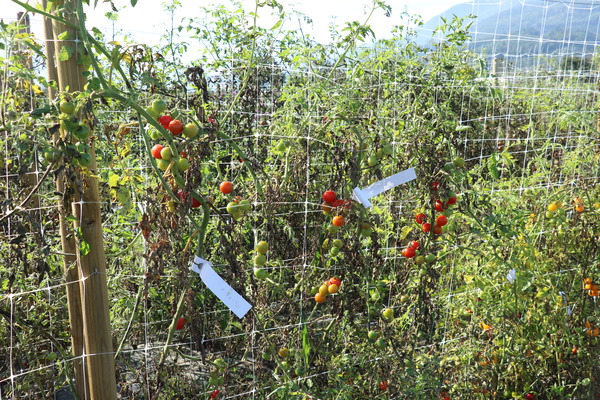
Picture: conventional tomato breeding by free recombination of the genes induced by deliberate crossbreeding
Genetically modified plants – a story to tune in to
The following story may illustrate how strongly the topic moves people in Central Europe. A few years ago, when I noticed that the apple trees in one of our breeding fields that is located next to a walking path hardly had any fruits on them for us, the breeders (the apples had been harvested by passers-by long ago), we put up a yellow barrier tape and wrote this in red on a poster: Attention! Genetically modified plants!
Although this was and is a technically and linguistically correct, factual and not further enigmatic message (the crossing of two varieties leads via the free recombination of genes indeed to genetically modified plants, in nature as well as in breeding), the theft stopped abruptly. But it only took one week left until I had the mayor on the phone, who asked friendly but worriedly about the “how and why” of the sign. (By the way, it is our luck that the mayor of Buchs is an agronomist and former vice-director of a research institute. 😉)
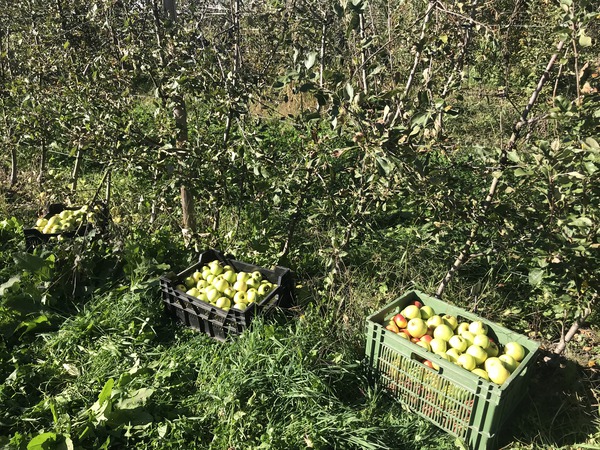
Picture: apple harvest in the breeding field for the Lubera® breeding juice
But this is clearly shown by history: the consumer is sensitised, is afraid, and does not want any genetically modified plants – and as the example shows... perhaps even no genetically engineered plants...This should be an important indication for all of us that we should also report as often as possible on the breeding work, that we should show how it happens naturally and talk about the successes and accomplishments that we achieve with it. We are in a time and a society that has become so frightened and conservative that it sometimes tends to value the old more than the new. Here, for example, one cannot preach and demonstrate often enough that old varieties are usually not old and forgotten because they are out of fashion, foolish or have been neglected, but because there are now more interesting new varieties that fit better into the current socio-cultural environment of the plant in various respects (yield, resistance, fruit quality, use): how and where is it planted, how is it used in the garden and in professional cultivation and how are the fruits harvested and used.
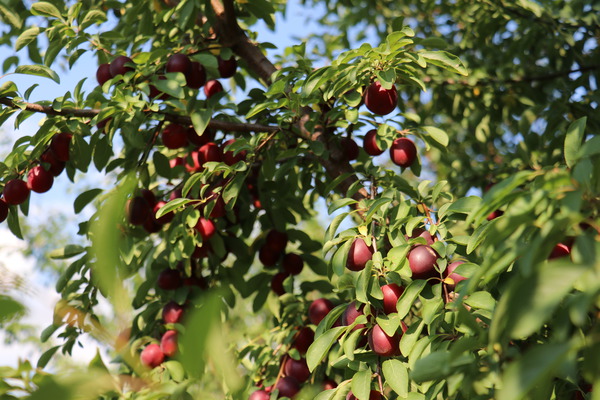
Picture: Robustikosen®, a Lubera® breed completely without crimping disease
No active genetic engineering methods in Lubera® breeding programmes
But let's get back to the crucial question: how do we at Lubera feel about genetic engineering? As breeders and as an industry, we have to take this fundamental scepticism seriously. For us at Lubera that means the following:
When breeding new varieties, we do not use genetic engineering methods that actively intervene in the genome, alter it or supplement it with foreign gene fragments. Period.
We believe that the difference between cisgenesis (genetic engineering within the same species or with related species = rather good) and transgenetics (artificial gene exchange between totally foreign species = fish genes in the pelargon = rather bad and evil), which has been newly developed by genetic engineers, is artificial and difficult to communicate. We also cannot support the hypocrisy of the Crispr apologists (with this technique one can no longer see from the result how the varieties were produced) with the current state of knowledge. And actually there is no need to examine the alternatives with regard to the strategic business decision and due to the legal situation: we live from our customers, and at Lubera we live much more from our own customers because we sell our varieties first directly via our websites Lubera.com and Lubera.co.uk – and our customers do not want genetic engineering. It is characteristic for the discussion and the fronts of this discussion that the apologists of genetic engineering do not live from real customers, but from the government (which finance the corresponding institutions).
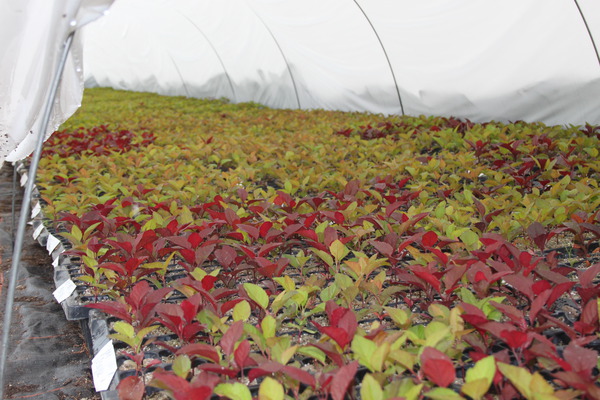
Picture: apple seedling in a plastic tunnel for testing of scab resistance
Passive-analytical genetic engineering methods in Lubera breeding
However, at Lubera® we use passive genetic engineering methods that only analyse the genes and help with the selection. In general, this area of application is described as marker-assisted breeding. Ultimately, the aim is to use analytical and passive methods in order to select and analyse the genes of a plant at an early stage (as a seedling) so that we can select genotypes that meet our breeding goals more quickly, more reliably and more cost-effectively. This year (2019) we have used such methods for the first time in tomato breeding (selection for Phytophthora resistance) and we will use similar methods in the future for apple breeding and possibly in other areas...But all of these methods do not actively interfere with the genome, we only try to understand it better. Or to also explain it this way: we don't write a new sentence, but only read the existing genes...
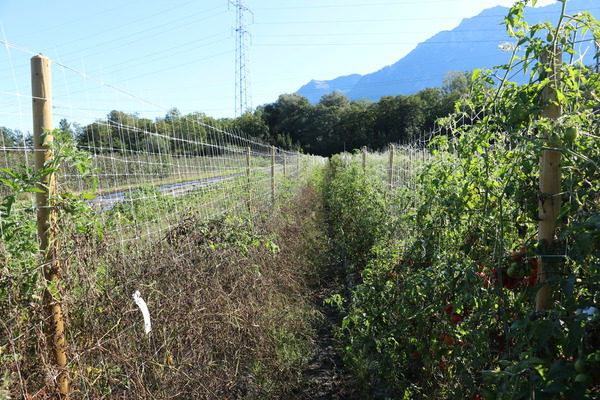
Picture: Lubera® tomatoe breeding field, tests for genetic markers help us in the pre-selection of the seedlings
Philosophical aspects – five thoughts on the discussion regarding genetic engineering
Genetic engineering, its various sub-disciplines and applications are highly controversial in society. On the one hand, there is almost the entire united scientific community, which may not understand why not everything that is possible should also be done. If this argumentation falls behind, science also likes to upgrade morally and points to the objectively existing problem of feeding a growing and more and more urban world population. On the other hand, there are the moral-ethical and often green-tinted critics (who, however, represent a clear majority of the Central European population). The critics sometimes find it visibly difficult to teach real technical reasons for their rejection of genetic engineering in addition to the moral and ethical motives...
As already mentioned, our company position and strategic orientation are clear. But I would like to contribute five open, unfinished thoughts for discussion and further reflection:
1. I consider the technical risks of genetic engineering and its various forms to be rather low, but not negligible. It is to be hoped that at some point pragmatic thought patterns will gain the upper hand here, too, where risks and opportunities are weighed up responsibly and where decisions are made rationally. However, we are not that far yet.
2. I understand the moral-ethical concerns, but I cannot share them in the quasi-religious form that is usually expressed. This is especially true when I look at nature, where recombinations, mutations and even genetic leaps not only occur, but also represent the substance from which evolution functions. As a society, we obviously have difficulties in thinking of man as an actor of evolution. In a certain way, I am even convinced that we have to allow evolution to be accelerated because our world is also accelerated because it is man-made. My “ethical” limit is reached when plants are to be banned (as is now the case in Switzerland in the discussion about successful neophytes). We should not ban what the air gives us to breathe.
3. As already mentioned above, the best argument on the genetic engineering side is ultimately to feed a growing world population, which is also living more and more in cities. But I don't hear anything from this side when it comes to defending the plant and its freedoms in principle: plant bans, nonsensical plant passports and import bans are already unnecessarily stopping the flow of genes today. Today it is almost impossible to bring new fruit plants to the United States, for example, at acceptable costs and in reasonable time. In the long term, this will slow down the adaptation of plants to our lifestyles and new environmental conditions more than the ban on the cultivation and marketing of genetically engineered new plants.
4. A similarly structured accusation can also be made against the other side. The same political and social circles, which are strictly opposed to genetic engineering, rightly draw attention to climate change and demand a reversal. However, they systematically prevent the adaptation of the plant world to new conditions with a strange backward-looking attitude (old varieties, only native plants, and the prohibition of successful neophytes). Recently we could all read it: our climate has become 1.5°C warmer in the last 50 years. The NZZ (Neue Zürcher Zeitung, a Swiss daily newspaper) summarises the results as follows: "The climate is not changing uniformly. Depending on the region, Earth's atmosphere has warmed to different degrees. The average temperature in Switzerland, for example, has risen by about two degrees Celsius, more than twice the global average. In 2017, it was 1.6 degrees warmer than the average temperature between 1961 and 1990."
It is unlikely that this can be reversed. This makes it all the more necessary to actively adapt the plant world through breeding, but also through gene flow and plant migration, and to adapt passively.
5. Here is one last thought on genetic engineering: I suspect that the scientific-industrial complex in agronomy does not only pursue selfless goals (= world nutrition) with genetic engineering – genetic engineering methods for self-preservation and enhancing one's own position fit too well. Breeding thus turns from a partial art into a purely mathematical science; the work can be done cleanly and in a white coat in the laboratory, everything becomes faster and thus easier to predict and finance. It is often overlooked that genetic breeding methods usually only produce variants of the same variety (variety x with the property y). The dice game of free recombination is limited, thus the productive chance is further eliminated and also the creativity of the breeder remains within very narrow limits. I have a well-founded fear that a broader approval of genetic engineering that actively intervenes in the genome will make our agronomic and horticultural plant world not really richer, but more streamlined and boring.
